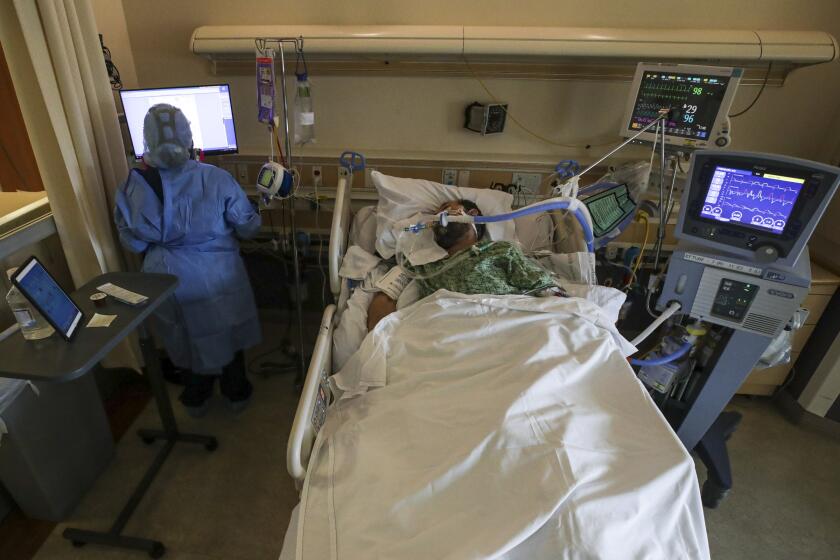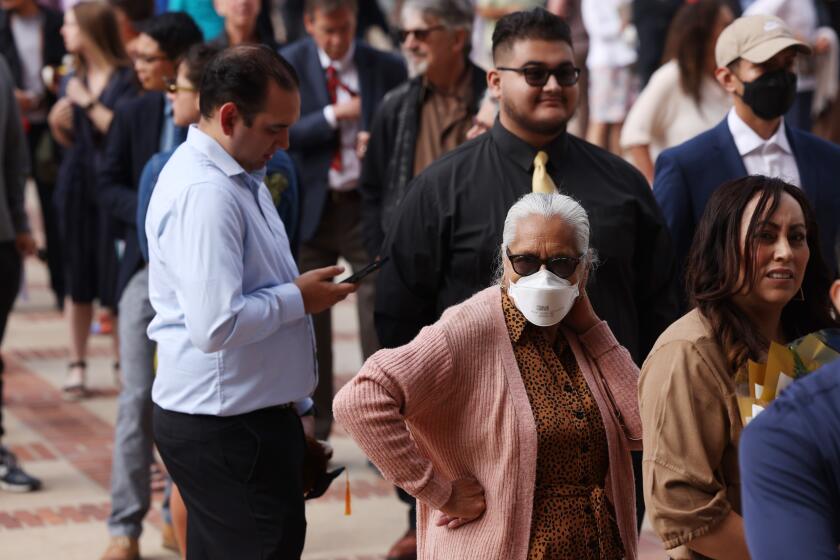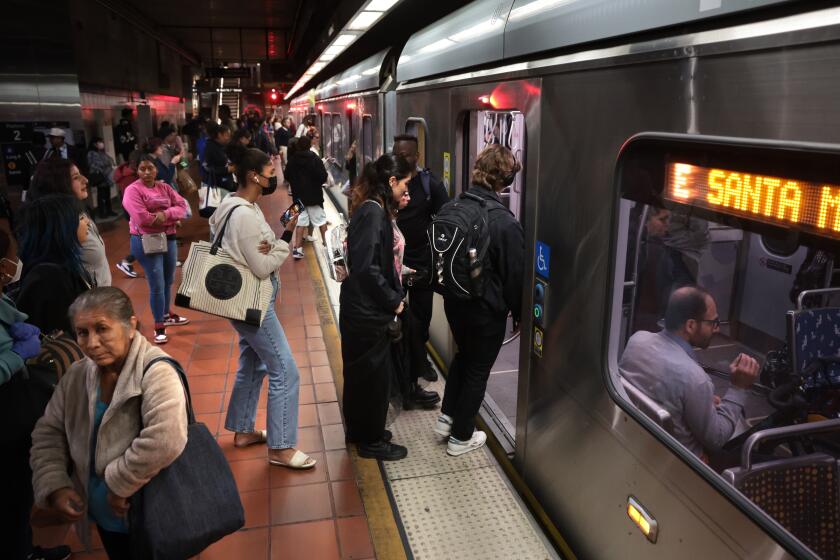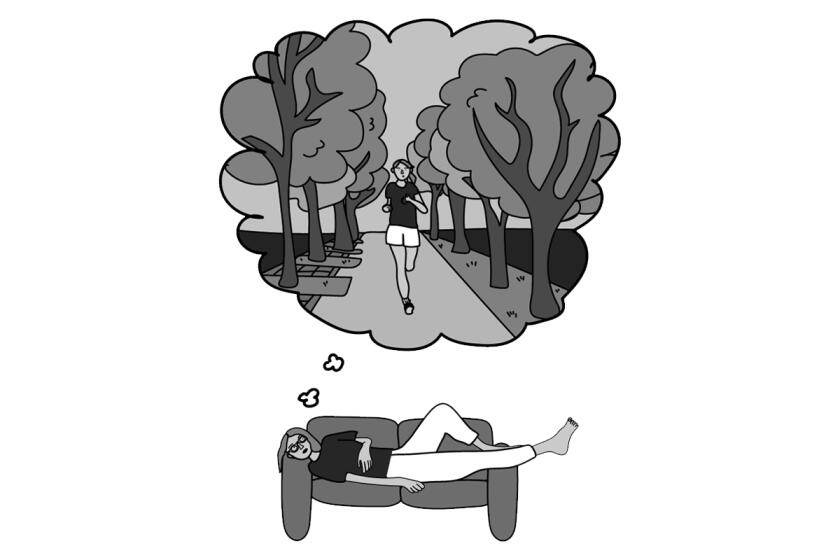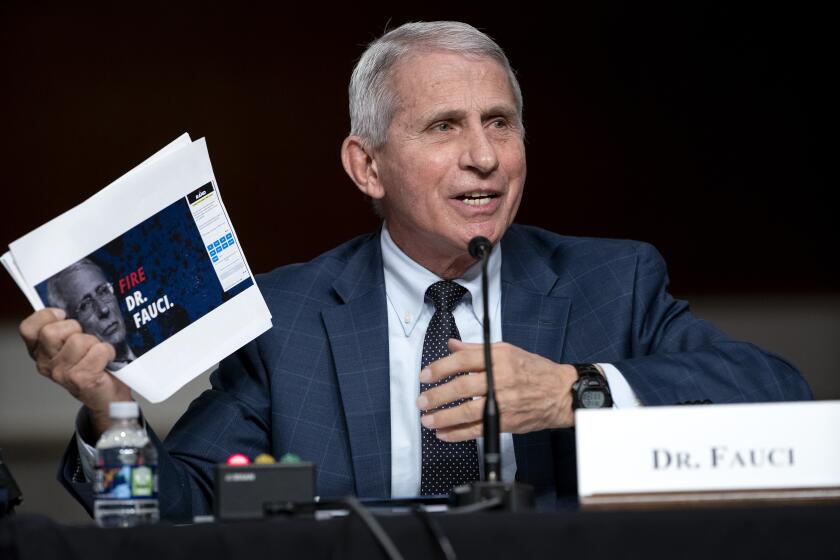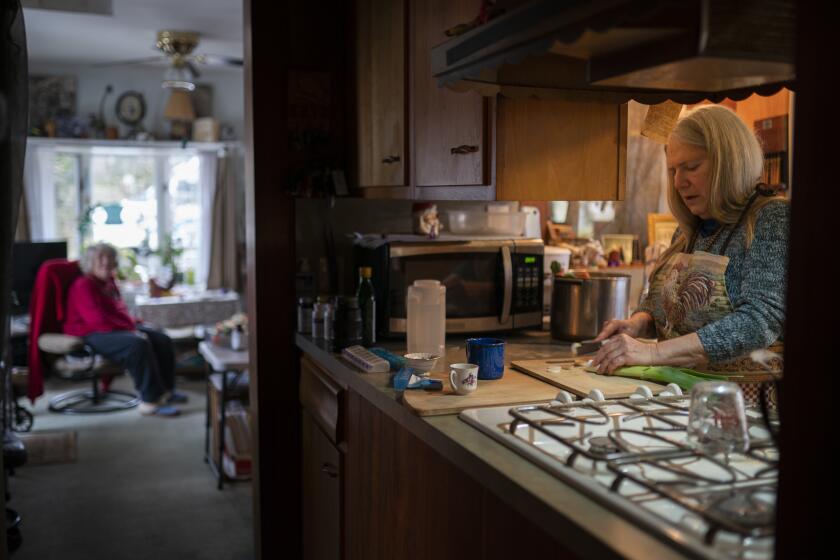‘Playing COVID roulette’: Some infected by FLiRT variants report their most unpleasant symptoms yet
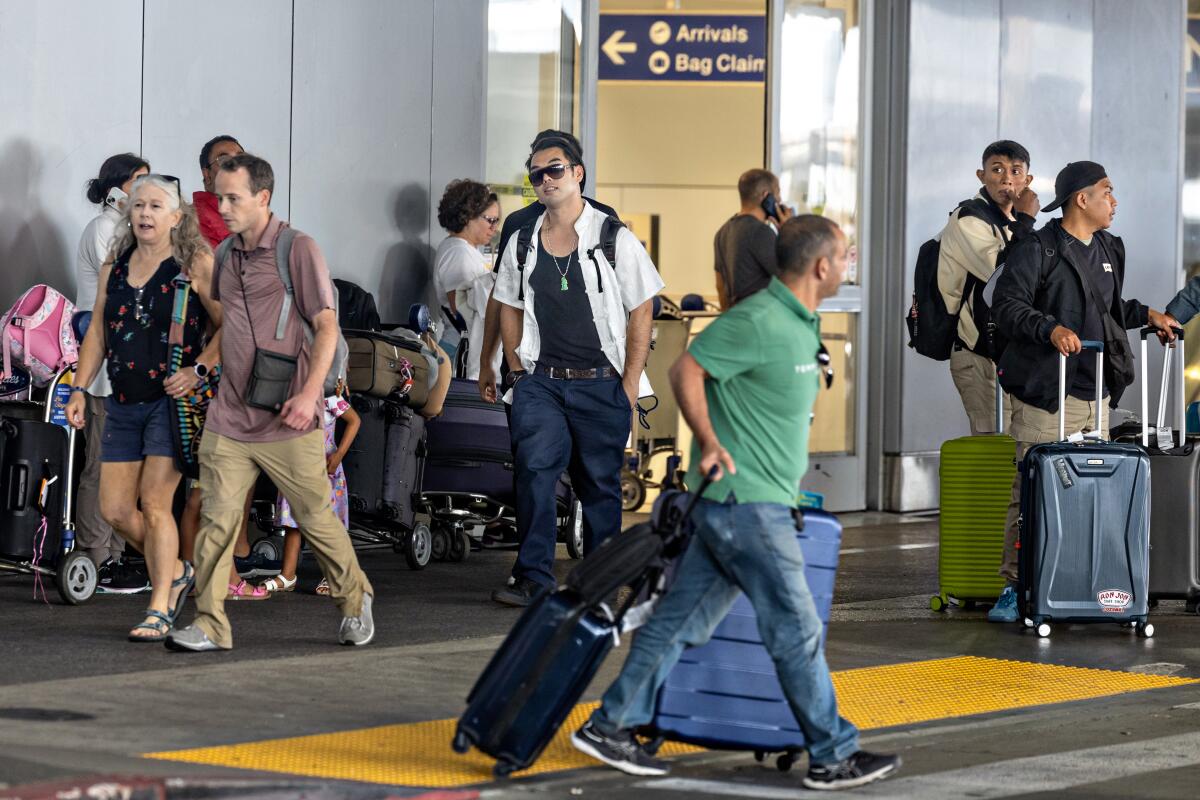
- Share via
As the summer travel season picks up, COVID cases and hospitalizations are rising in Los Angeles County — and some of those recently reinfected are finding their latest bout to be the worst yet.
There are no signs at this point that the latest coronavirus variants are producing more severe illness, either nationally or in California.
But some doctors say this latest COVID rise challenges a long-held myth: Although new COVID infections are often mild compared with a first brush with the disease, they still can cause severe illness. Even if someone doesn’t need to visit the emergency room or be hospitalized, people sometimes describe agonizing symptoms.
“The dogma is that every time you get COVID, it’s milder. But I think we need to keep our minds open to the possibility that some people have worse symptoms,” said Dr. Peter Chin-Hong, a UC San Francisco infectious diseases expert.
Each time you get COVID, he said, is “kind of like playing COVID roulette.”
This underscores the need for caution during summer travel and activities, even though the overall risk remains relatively mild.
This past winter, the mortality rate for patients hospitalized with COVID-19 was 35% higher than for patients hospitalized with the flu.
Since everyone’s experience with COVID is different and influenced by a number of factors, it’s difficult to quantify how many are experiencing more acute symptoms now compared with previous infections. But anecdotally, including on social media sites, people are expressing shock at how sick they’ve become from the latest subvariants, which have been collectively nicknamed FLiRT.
“I’ve had COVID a few times but this is the worst I’ve had it,” wrote one person on Reddit. The person reported recurring fever, being so congested they couldn’t breathe out of their nose, “terrible sinus pressure and headache ... and I can’t stand up for too long without feeling like I’m about to pass out.”
“Previously COVID just felt like the common cold, but this strain is [wreaking] havoc,” the person wrote. “I don’t like to complain like this, but I’m shocked at how much it’s taking me out.”
Another person wrote that their “throat feels like razor blades” and that they feel like they’re “in living misery.”
“I have so much phlegm, but it hurts so bad to cough because my throat is on literal fire!!” the person wrote. “This is my 4th time having Covid and I swear I feel like this is the worst it’s ever been!!”
The latest daily tally of new coronavirus cases is the highest since February, when the winter peak was falling. And it’s an undercount.
Others who eluded COVID for more than four years got infected this summer.
One person fell ill and tested positive for the first time after hosting a Father’s Day gathering for 12 people. The person described “uncontrollable body-shaking chills so bad I couldn’t feel most of my fingertips.”
A 42-year-old nurse, who has had COVID four times, said their latest illness has been “intense with fevers, cough, head pressure and pain. It’s attacking my throat and ability to swallow.”
Others, though, have said each subsequent COVID illness has been easier to recover from. And one first-time infected person wrote that they had “super mild symptoms [that] just feels like a seasonal allergy” flare-up.
Some studies back up the idea that subsequent COVID infections pose additional risks. A 2022 report in the journal Nature Medicine, focused on veterans, found that, “Compared to noninfected [people], cumulative risks and burdens of repeat infection increased according to the number of infections,” heightening the risk of medical problems, hospitalization and death.
It’s too early to know if FLiRT will be a major change in the COVID picture; so far impacts have been small. But officials are urging Californians to be prepared.
And while the prevalence of long COVID appears to be declining, doctors note there is risk of developing the syndrome with each infection. A report published by the U.S. Centers for Disease Control and Prevention last summer said the prevalence of long COVID among U.S. adults was 7.5% in early June 2022, but had decreased as of mid-June 2023 to 6% — still a notable share of the population.
There are a number of potential reasons why a subsequent COVID illness might feel worse than the first. Say a person who was vaccinated and last boosted in 2021 got infected in 2022 and then again in 2024. The relatively long gap of not being exposed to infection, or a booster, “maybe led to [their body] not having as much immune memory. And the variants have changed so much anyway, it’s like getting exposed to something relatively different from what virus the immune system had seen earlier,” Chin-Hong said.
Without staying up-to-date on COVID vaccinations, which “remind the immune system of what the more current variants look like,” a recent infection may cause the body to act relatively surprised to the FLiRT subvariants that are now dominant nationwide.
“It’s evolved so much, and the body is, like, ‘O-M-G, what is this thing that I’m seeing?’ ” Chin-Hong said.
The logic is much the same for annual flu shots, which are formulated each year in hopes of priming the immune system against the dominant circulating versions of that virus.
People at work were understanding when the illness became overwhelming, but in truth even I didn’t understand. Neither did the doctors.
For the week ending Saturday, an estimated 70.5% of COVID specimens nationwide were of the FLiRT subvariants — officially known as KP.3, KP.2 and KP.1.1 — up from 54.9% a month earlier. Another closely related subvariant, LB.1, is estimated to comprise 14.9% of specimens, up from 10% a month earlier.
Prior immunity from old vaccinations can still do a decent job of protecting many people against getting seriously ill. But without the refresher that comes with an updated vaccine, Chin-Hong said the immune system “probably won’t be able to stop the virus in its tracks, or neutralize the virus as soon as it comes in, because it looks so different, before kicking in memory immunity.”
“In the meantime,” he added, “this virus is infecting cells happily, while the body is trying to use its current memory to make new immune cells.”
It’s also notable that, even for younger adults who are considered up-to-date on their COVID immunizations, it’s been nearly a year since their last vaccination, and the effectiveness of the vaccine weakens over time.
A report published by the CDC in February found that getting the updated 2023–24 COVID vaccine provided about 54% increased protection against symptomatic illness compared with not getting the shot. Vaccine effectiveness against symptomatic infection is higher in the first few months after getting the updated shot.
In his memoir ‘On Call, A Doctor’s Journey in Public Service,’ Anthony Fauci fights back against the right-wingers and anti-vaxxers whose profit-seeking lies have cost the lives of thousands of Americans.
The vaccines continued to provide good protection against hospitalization and death.
In L.A. County, COVID cases and hospitalizations continue to rise. For the week ending June 30, there were an average of 229 coronavirus cases a day reported, up from 106 a month earlier. And for the week ending June 29, there were an average of 197 coronavirus-infected people in hospitals per day, up from 117 a month earlier. And while COVID hospitalizations are now higher than they were at this same point last year, they remain below the relatively mild peak seen in summer 2023.
Officially reported cases are an undercount, as they only factor in tests done at medical facilities, and don’t account for at-home tests or those who don’t test. In L.A. County, last summer’s COVID spike peaked in late August at 571 cases a day, and hit a maximum of 620 coronavirus-infected people per day in hospitals in early September.
Viral levels in L.A. County wastewater have been relatively stable. For the week that ended June 22, the most recent available, viral levels in sewage were at 17% of the peak from the winter of 2022–23, the same as the prior week. Last summer peaked in early September, where viral levels in sewage were at 38% of the prior winter’s peak.
The rate at which coronavirus tests are coming back with positive results continues to climb across California. For the week ending July 1, 10.6% of coronavirus tests statewide came back positive, up from 4.1% a month earlier. Last summer’s positive test rate peaked at 13.1%, toward the end of August.
People who have had COVID-19 have a significantly higher risk of suffering chronic fatigue than those who haven’t had the disease, a new CDC study shows.
There has been relatively low uptake of the updated COVID vaccine, which became available in September. Since then, 36.7% of California’s seniors age 65 and up have received at least one dose of the updated vaccine, as have 18.5% of adults age 50 to 64, and 10% of the youngest adults, up to age 49.
For people who haven’t gotten an updated vaccine within the last year, “you should think about getting it, especially if you’re older and immune compromised,” Chin-Hong said. There continue to be hundreds of COVID deaths reported nationally every week, with seniors and immune-compromised people most at risk.
Even getting the 2023-24 vaccine now will still allow you to get the updated COVID vaccination that is on track to become available this fall. The CDC will recommend everyone 6 months and older get the updated 2024-25 version of the vaccine.
A good time to get the 2024-25 COVID vaccination is in October, Chin-Hong said.
Dr. Peter Hotez is a vaccination expert who has nothing to do with COVID. The GOP’s COVID committee just put him in its crosshairs -- but why?
Chin-Hong said that even healthcare workers need to be reminded of proper COVID infection control protocols, like the importance of testing when you feel sick, and reporting your illness to your employer.
“It’s like everybody seems to be thinking COVID is just like normal now,” Chin-Hong said. But taking sensible measures — like coworkers deciding to not go into work when sick, and testing themselves when symptomatic — can make a world of difference in keeping COVID limited to a smaller number of people.
And with COVID rising, it’s also a reminder that it’s sensible to keep a mask in your pocket to don if you happen to be near an ill person, Chin-Hong said.
More to Read
Sign up for Essential California
The most important California stories and recommendations in your inbox every morning.
You may occasionally receive promotional content from the Los Angeles Times.
